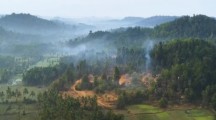Abstract
In 1508, the Scottish printers Walter Chepman and Androw Myllar published a small book containing the alliterative romance Golagros and Gawane, which follows the adventures of King Arthur on pilgrimage to the Holy Land. This article argues that its publication in 1508 sheds light on how this poem may have been read by its Scottish audiences, specifically in terms of anxieties caused by the Ottoman conquest of Constantinople in 1453 and the subsequent expansion of the Ottoman Empire. Although other scholars argue that Arthur suffers from excessive pride and greed, This article argues that the narrator’s descriptions of landscape, particular the situation of castles, offer another interpretation: Golagros’s castle appeals to Arthur because of its military fortifications, a potential holding point should the Ottoman Turks penetrate that far into France. More importantly, This article argues that Golagros and Gawane reflects James IV’s interest in crusading and European diplomacy. The 1508 publication of Golagros and Gawane places the text’s distribution firmly in the reign of James IV of Scotland, a figure described by C.S. Lewis as a man “much like Arthur himself.” This article draws parallels to Arthur with James IV by examining Arthur’s perception of the second castle and his interactions with Golagros in order to establish Arthur, traditionally viewed in this poem as a secular king, as a defender of sacred interests. Here, in the body of Arthur, and by extension James IV, is a king who can unite the lands of Christendom against the Ottomans.
Similar content being viewed by others
References
Alexander, F. (1975). Late medieval Scottish attitudes to the figure of King Arthur: A reassessment. Anglia: Zeitschrift fur englische Philologie, 93(1–2), 17–34.
Barron, W. R. J. (2005). Bruttene deorling: An Arthur for every age. In N. J. Lacy (Ed.), The fortunes of King Arthur (pp. 47–76). Cambridge: D.S. Brewer.
Chalmers, T. (2004). James IV (1473–1513). In H. C. G. Matthew & B. Harrison (Eds.), Oxford Dictionary of National Biography (Online ed.). http://0-www.oxforddnb.com.source.unco.edu/view/article/14590.
Fradenburg, L. O. (1991). City, marriage, tournament: Arts of rule in late medieval Scotland. Madison, WI: University of Wisconsin Press.
Hahn, T. (Ed.). (1995). The Awntyrs off Arthur. In Sir Gawain: Eleven romances and tales (pp. 178–226). Kalamazoo, MI: Medieval Institute Publications.
Hahn, T. (Ed.). (1995). The knightly tale of Gologras and Gawain. In Sir Gawain: Eleven romances and tales (pp. 234–308). Kalamazoo, MI: Medieval Institute Publications.
Hanna, R. (2008). Introduction. In R. Hanna (Ed.), The knightly tale of Golagros and Gawain (pp. 11–14). Woodbridge: Boydell & Brewer.
Ketrick, P. J. (1931). The relation of Golagros and Gawane to the Old French Percival. Washington, DC: Catholic University of America.
Leslie, J. (1830). The history of Scotland: From the death of King James I, in the year M. CCCC. XXXVI, to the year M.D. LXI. Edinburgh: Bannatyne Club.
Lewis, L. (2006). Chepman and Myllar: The first printers in Scotland. In J. Hinks & C. Armstrong (Eds.), Worlds of print: Diversity in the book trade (pp. 57–69). New Castle: Oak Knoll.
Macdougall, N. (1989). James IV. Edinburgh: John Donald Publishers.
Mackie, R. L. (1958). King James IV of Scotland: A brief survey of his life and times. Westport: Greenwood Press.
Macquarrie, A. (1985). Scotland and the crusades: 1095–1560. Edinburgh: John Donald Publishers.
Mainer, S. (2010). The Scottish romance tradition c. 1375-c. 1550: Nation, chivalry and knighthood. Amsterdam: Rodopi.
Parkinson, D. (1991). Scottish prints and entertainments, 1508. Neophilologus, 75(2), 304–310. doi:10.1007/BF02398482.
Prestwich, M. (2004). Edward I (1239–1307). In H. C. G. Matthew & B. Harrison (Eds.), Oxford dictionary of national biography (Online ed.). http://0-www.oxforddnb.com.source.unco.edu/view/article/8517.
Purdie, R. (2005). The search for Scottishness in Golagros and Gawane. In R. Purdie & N. Royan (Eds.), The Scots and medieval Arthurian legend (pp. 95–107). Cambridge: D.S. Brewer.
Rushton, C. (2005). ‘Of an uncouthe stede’: The Scottish knight in Middle English Arthurian romances. In R. Purdie & N. Royan (Eds.), The Scots and medieval Arthurian legend (pp. 109–119). Cambridge: D.S. Brewer.
Schiff, R. P. (2011). Revivalist fantasy: Alliterative verse and nationalist literary history. Columbus, OH: Ohio State University.
Schwoebel, R. (1967). The shadow of the crescent: The Renaissance image of the Turk (1453–1517). New York, NY: St. Martin’s Press.
Author information
Authors and Affiliations
Corresponding author
Rights and permissions
About this article
Cite this article
Bovaird-Abbo, K.L. “Reirdit on ane riche roche beside ane riveir”: Martial Landscape and James IV of Scotland in The Knightly Tale of Golagros and Gawane . Neophilologus 98, 675–688 (2014). https://doi.org/10.1007/s11061-014-9377-5
Published:
Issue Date:
DOI: https://doi.org/10.1007/s11061-014-9377-5




